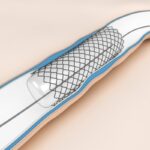Original title: Comparison of coronary artery bypass surgery and percutaneous coronary intervention in patients with diabetes: A meta-analysis of randomized controlled trials. Reference: Verma S. et al. Lancet Diabetes Endocrinol. 2013;Epub ahead of print. The FREEDOM study was the last of the randomized studies that compared the results of surgery versus coronary angioplasty in diabetic multivessel patients showing a...
Enoxaparin appears superior to unfractionated heparin in patients undergoing primary angioplasty
Original title: A direct comparison of intravenous enoxaparin with unfractionated heparin in primary percutaneous coronary intervention (from the ATOLL trial). Reference: Collet et al. Am J Cardiol. 2013; Epub ahead of print. ATOLL study analysis suggests that enoxaparin is superior to unfractionated heparin in reducing ischemic events and mortality in patients suffering ST elevation acute myocardial infarction (STEMI)...
Thromboaspiration in AMI, without benefit to 30 days.
Original title: Thrombus Aspiration during ST-Segment Elevation Myocardial Infarction. TASTE trial. Reference: Ole Fröbert et al. N Engl J Med 2013. DOI: 10.1056/NEJMoa1308789 One of the biggest challenges of primary angioplasty is to restore normal coronary flow. Thromboaspiration is a relatively simple, quick and cheap it can improve the flow and resolution of ST , however , the...
Intravascular imaging for event prediction: looking beyond the lumen.
Original title: Thinking Out of the Lumen: FFR Vs. Intravascular Imaging for MACE Prediction. Reference: Pedro R. Moreno et al. J Am Coll Cardiol, article in press. Intravascular imaging studies have shown that the lesions most likely to produce coronary events usually have modest luminal stenosis, large cap burden and thin fibrous cap. These plaques will evolve into a...
COURAGE patients who crossed branch.
This editorial comment was written by SOLACI.ORG and is based on an original article by Medscape which can be accessed free of charge at the bottom of this page. COURAGE patients (Patients in the Clinical Outcomes Utilizing Revascularization and Aggressive Drug Evaluation) who crossed from the optimal medical treatment branch to the revascularization branch within...
2nd generation drug-eluting stents intended for left main coronary artery
Original title: Zotarolimus- versus Everolimus-Eluting Stents for Unprotected Left Main Coronary Artery Disease. ISAR-LEFT MAIN 2 Study. Reference: Julinda Mehilli et al. J Am Coll Cardiol, article in press. Improvements in 2nd generation drug-eluting stents led to increased efficiency and safety , however there is little information on these new platforms to treat left main coronary artery ....
Zotarolimus-eluting stent in-stent restenosis
Original title: Clinical Outcomes of the Resolute Zotarolimus-Eluting Stent in Patients With In-Stent Restenosis Two-Year Results From a Pooled Analysis. Reference: Gert Richardt et al. J Am Coll Cardiol Intv 2013, article in press. Previous studies reported a target lesion revascularization (TLR) of 15% and target vessel (TVR) of 22% after a year of treating an injury-stent restenosis....
Multislice computed tomography for bioresorbable scaffolds: the end of invasive diagnostic studies?
Original title: Multislice Computed Tomography Angiography for Non-invasive Assessment of the 18-Months Performance of a Novel Radiolucent Bioresorbable Vascular Scaffolding Device (ABSORB Trial). Reference: Koen Nieman et al. J Am Coll Cardiol, article in press. Metal stents revolutionized coronary angioplasty procedures; however, they are permanent prosthetic devices that make re intervention difficult and prolongue thrombosis risk. This problem...
High doses of radiation also in peripheral procedures
Original title: Patient radiation exposure during percutaneous endovascular revascularization of the lower extremity. Reference: Einat Segal et al. Journal of Vascular Surgery. Article in press. Percutaneous endovascular revascularization is emerging as the first line treatment for peripheral artery disease for both intermittent claudication and chronic critical limb ischemia. Radiation doses for these interventions, usually prolonged, have not been...
Carotid angioplasty prior to central venous catheter. The best option to solve combined problems.
Original title: A Direct Comparison of Early and Late Outcomes with Three Approaches to Carotid Revascularization and Open Heart Surgery. Reference: Mehdi H. Shishehbor et al. J Am Coll Cardiol, article in press. The prevalence of severe carotid stenosis (> 80%) in patients planning to have a Central Venous Catheter (CVC) is estimated at between 6 and...









